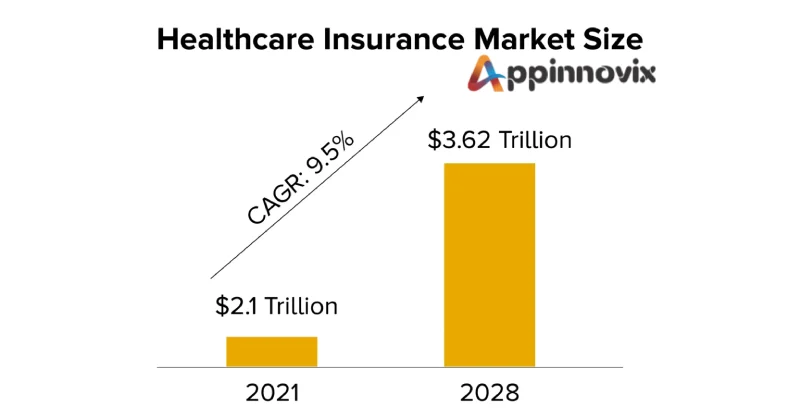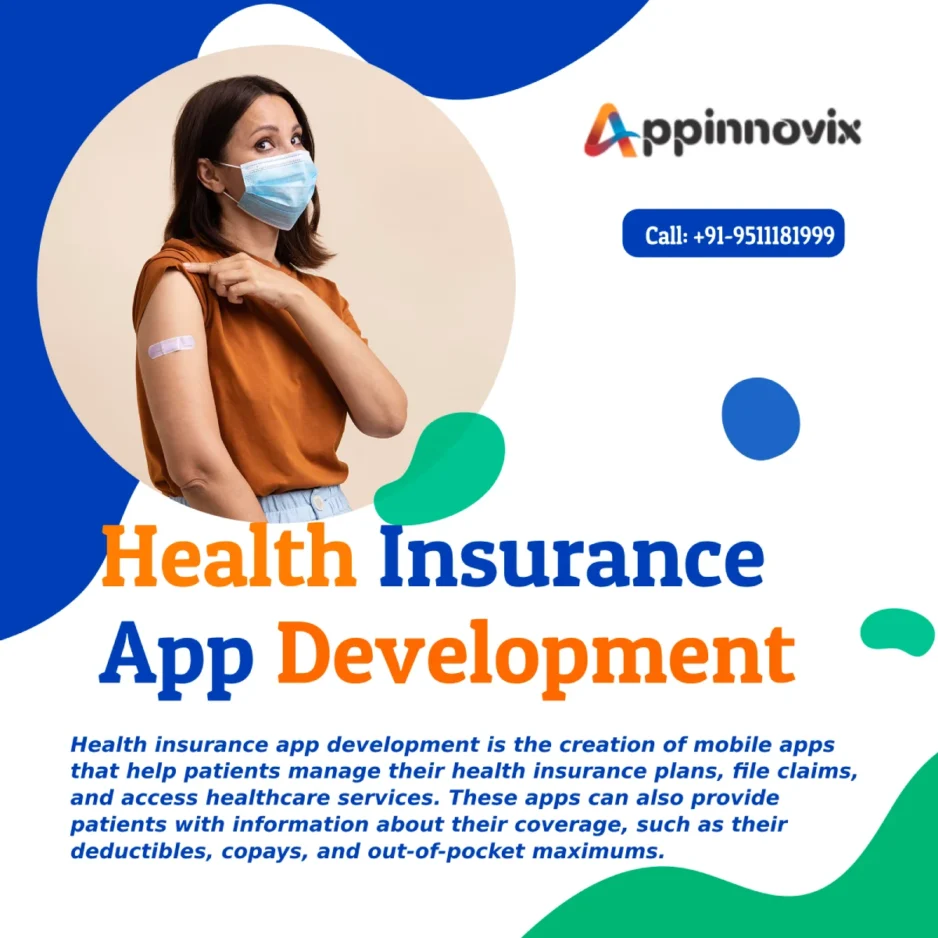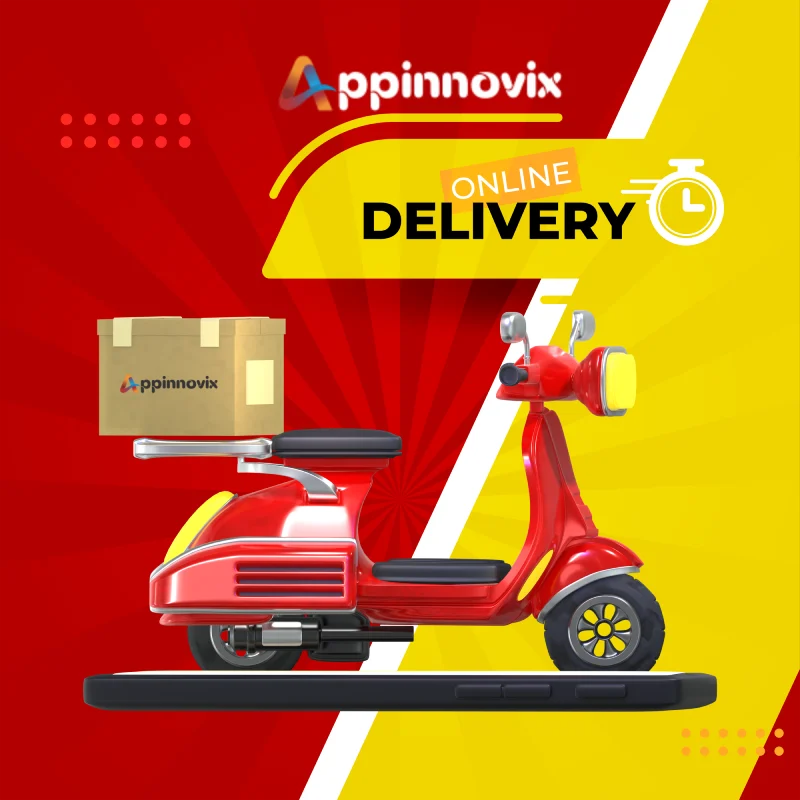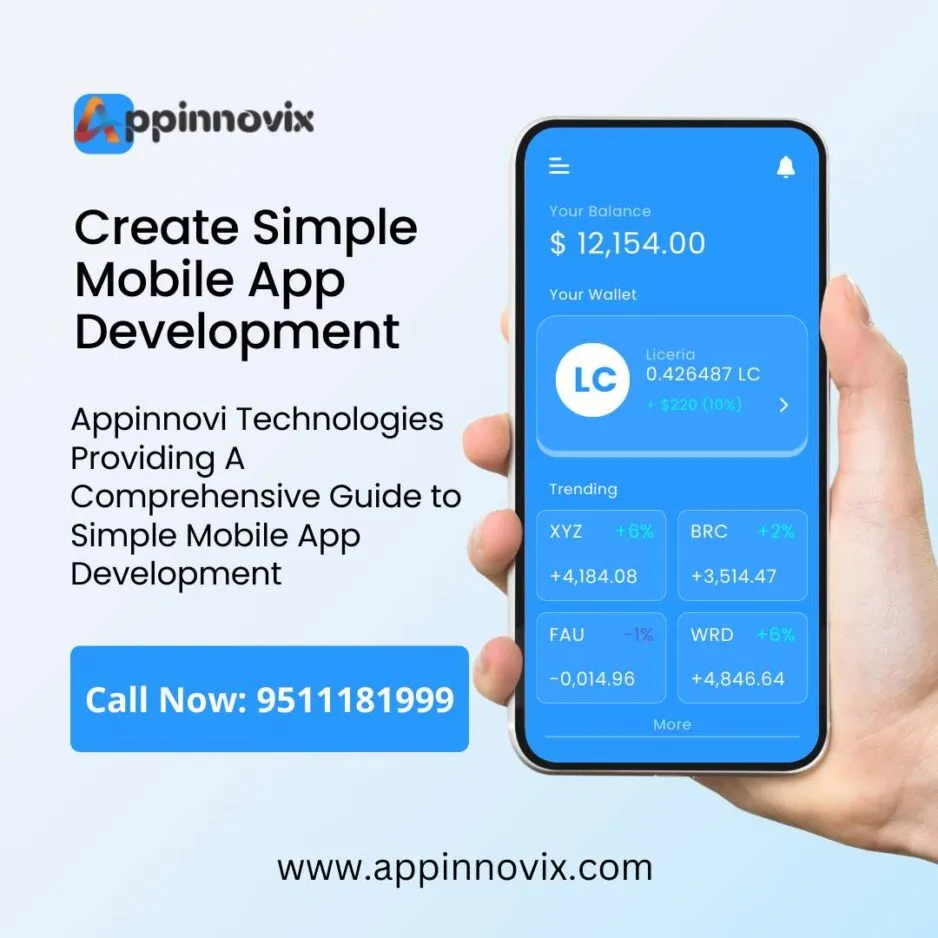Do you know Health Insurance App Development? Yes? Congratulations! You are a millionaire in the next 5 years! Yes, you heard that right. The Health Insurance or Medical Insurance business is the fastest-growing business these days. According to Forbes, before the pandemic, the Indian health insurance market was growing at a 24% compound annual growth Rate. However, this percentage jumped to 34% with the outbreak of the novel coronavirus. Further research estimates that the global health insurance market is likely to reach $4.15 trillion by 2028.
In addition to the health insurance sector, another sector that showed growth during and after the pandemic is the IT sector! And if you are an App developer, then friend, you are on the right page right now! You can become a millionaire in the next 3 years if you know the health insurance app development process well. So, in this blog post, Appinnovix is sharing the ultimate guide to health insurance app development that can help you know the health insurance application development process, cost, and features better. Scroll down, and understand medical insurance apps in detail.
Table of Contents
What is Health Insurance or Health Cover?
Health Insurance or medical insurance is a type of insurance that helps you save money for expenses occurring due to a medical illness. In simple words, it is a kind of investment scheme where you also receive interest. But you can use this investment only for medical expenses. If you are lucky enough not to fall ill all through your life, the insurance cover goes in vain like a lottery unwon.
Another important point to note about medical insurance is that health insurance policy coverage is applicable only in cases of hospitalization. So, it does not mean that the health insurance cover relieves you of doctor’s fees and normal illness expenses. However, it is a good investment for future hospitalization occurring in middle and old age.
After witnessing the recent pandemic, the health insurance market has demonstrated unexceptional growth. Also, the health insurance market is expected to grow further in the upcoming years. Eventually, health insurance app development is also rising in demand. People tend to buy online health insurance via health insurance applications. The most popular medical insurance apps include Acko, Policy Bazar, Insurance Dekho, and Digit in India.
Need for Health Insurance Cover in India
Rapid urbanization and modernization in India have also resulted in increased stress and pollution levels. When stress and pollution levels increase simultaneously, the product acts as a catalyst for serious medical conditions. Did you know that WHO has estimated in recent studies that India ranks highest among nations where premature death rates are rising?
Further healthcare stats in India indicate that-
- Around 60% of deaths in India are due to Non-Communicable diseases.
- Also, around 5.8 Million Indians die of cancer, diabetes, and heart and lung diseases on an estimate.
- Another estimate reveals that Indians have an average life span of 72 years only.
- As per the latest data available, during the time of the COVID-19 pandemic, the number of active COVID-19 cases was found to be 45,001,245. Whereas, the number of deaths was 532,037.
- Moreover, reports reveal that Indian households spend around Rs. 120/- billion INR on healthcare each year.
- Surprisingly, 42.3% of the spenders comprise urban audiences while the remaining 57.7% comprise rural audiences.
As a matter of fact, In India, if you want good healthcare facilities from a reputed hospital such as Max, Vedanta, Appollo, or Fortis, then clearly you need to have a great budget. A single visit may cost a person up to INR 5,000/-. And proper cure requires multiple visits. Unluckily, if you are hospitalized, per day charges range between 10,000/- to 50,000/- depending upon the hospital. Whereas, a surgery might cost anywhere between 1/- lac INR to 1/- crore INR depending upon the illness. Additionally, the predicted inflation rate in India is already 6.83%.
Therefore, it is very clear that in spite of the great healthcare facilities available in India, finances obstruct access to these facilities. Especially, in the case of Middle-Income and low-income groups, healthcare facilities seem to be out of reach. However, medical insurance can help one to bridge this gap and improve accessibility.
Health Insurance App Development: Cost, Features, and Benefits Analysis

The growth in Health Insurance App Development technology has proved to be a boon for Indians. The latest studies indicate that around 65% of Indians would prefer to buy health insurance via a health insurance mobile app.
Let us now understand the use of the above information in the context of health insurance app development. Health Insurance companies are already marketing health insurance plans in India with huge pomp and show. So, as web developers, we are not supposed to sell a health insurance plan.
Rather our job is to keenly study the health insurance market demands and emerging supporting technologies. By developing the most accurate medical insurance apps for the health insurance market, we can multiply our wealth by 50 times in no time!
So, let us have a look at the health insurance app development process, ideal health insurance app features, and some unfulfilled market demands at the time! By concentrating on the requisition medical insurance app features we can provide better alternatives to Policy Bazaar, Acko, Digit, and more!
Health Insurance App Development Market Overview
So, let us first discuss the health insurance app development market overview–

- Presently, Policy Bazaar is the most popular health insurance app in India with a revenue of INR 2,558/- crore.
- The top competitors of Policy Bazaar are Acko, Digit, and Insurance Dekho.
- Moreover, all these health insurance apps provide insurance premium calculators, policy comparisons, online buying, and tracking of health insurance as app features.
- However, a point worth noticing is that these apps are not specifically focused on Health Insurance. Rather, they provide all kinds of insurance online.
- For example, one can buy life insurance, car insurance, bike insurance, and any other form of insurance online via a mobile app.
- Post-pandemic, people are more health-conscious, and in India health and fitness app downloads increased by 156%.
- Furthermore, the fitness wearable market also grew by 66% between 2021 and 2022.
Clearly, health insurance mobile app development seems a promisingly profitable business. So, let us now discuss how we as app developers can think out of the box. And let us review the present medical insurance app development market situation!
What is the Current Health Insurance App Development Drawback?
The above stats pose two situations before us-
- There is no dedicated health insurance mobile app present in the market at present.
While the health insurance market is growing at a rapid rate, the existing mobile apps are still offering health insurance as an option. There is no specific mobile app to buy health insurance as of now.
The biggest drawback of this condition is that once these health insurance apps collect the buyer’s data, the other insurance agents such as life insurance agents keep on irritating the app visitor.
Ultimately, the downloader removes his profile from the app and also uninstalls the app downloaded.
- People Download Health and Fitness Apps More than Health Insurance Apps
It is another drawback for the Indian health insurance app market that people still rely less on health insurance policies. People are rather keener to download health and fitness apps. The health insurance app development market needs to pay attention to this. And believe us, this disadvantage can be turned into an advantage. How? Let us jump to Health Insurance App Development Features to Master in 2024.
What is Health Insurance App Development?
The current era is ruled by Information and Technology. On one hand, humans are being replaced by AI at a rapid rate. On the other hand, irreplaceable humans are those who have mastered the IT skills. Gone are the days when people used to stand in never-ending queues to pay bills and buy insurance. The birth of FinTech and InsureTech has changed the banking, finance, and insurance industries altogether.
Health Insurance App Development is the key to bringing digitalization to the field of health insurance market. In order to provide doorstep services to customers, health insurance companies need a mobile app. So that, like people buy online groceries and fashion accessories, they can also buy health insurance online without having to stand in long queues.
So, health insurance app development is the process of developing a mobile application that facilitates the buying of health insurance online. Also, a health insurance mobile app allows a person to compare different health insurance policies as per his/her age, sex, requirements, and affordability. The buyer can also check the hospitals covered under the policy online. And can buy insurance that best suits his/her requirements.
Health insurance mobile apps facilitate both the health insurance buyer as well as the provider. The health insurance company providing health insurance policies via mobile app can collect app visitor’s data. And this way it can convert the lead into a valuable customer. Also, they can have valuable data insights.
Need for Health Insurance App Development
Health insurance app development is very important due to the changed lifestyles and habits of people globally. Online shopping was already gaining popularity all over the world before the pandemic. However, people still preferred to visit crowded places sometimes for fun then. But, with the outbreak of the novel coronavirus and the resultant social distancing compulsion, the public shifted to online shopping dramatically.
Now people tend to perform as many tasks as possible online. This includes paying mobile bills, electricity bills, buying of groceries and fashion goods, and even dating. Therefore, buying an insurance plan offline makes no sense at all.
Eventually, health insurance companies anyhow need a health insurance mobile app. And therefore, health insurance mobile app development is a mandatory skill for any app developer.
Health Insurance App Development Features to Master in 2024
Now let’s discuss what features an app developer must master in the process of health insurance app development in 2024. So that he or she can bring about a revolution in the InsureTech market.
- Think Different and Introduce a Dedicated Fitness and Health Insurance Mobile App
As already discussed above under the section ‘What is the Current Health Insurance App Development Drawback, one focuses on a dedicated medical insurance app development. While other mobile apps are providing medical insurance as an option. You make it a priority. A focused Health Insurance App Development that serves only the healthcare and health insurance industry can make your app stand different.
Apart from the important health insurance app features, you can include fitness tracking features in the mobile app that you are developing. Additionally, providing an ecommerce section to buy health products, medicines, and wearables can also boost new market demand.
Currently, one of the health insurance apps in India is providing such facilities. In fact, there is no dedicated health insurance app in the Indian market at all. So, can encash this opportunity in 2024.
- Remember The Importance of Health Insurance App UI Design
Health Insurance App UI or health insurance app UX design also needs careful attention in the health insurance app development process. In fact, the UI/UX design of any mobile application plays the most vital role in its success.
An App UI or App UX design means Application User Experience (app UX) or Application User Interface (app UI). Simply put, it means how the app appears to the user (its colors, text fonts, options, simplicity in use, etc.).
Say, for example, the Policy Bazaar app has a blue home screen App Icon with the company’s name initials ‘PB’ in white. As soon as one touches the app icon, he lands on the main app page. The app is interactive and will ask the downloader about his age, sex, and the kind of insurance he or she is looking for. This way, we can say that the PB app is interactive in nature.
So, always focus on a simplified yet interactive health insurance app UI or medical insurance app UX. The more interactive and easy-to-use an app, the more number of users it manifests!
- Do Not Ignore the Health Insurance App API
So far, we have always discussed App UI and App UX designs in all of our technical articles. However, did you know that API also requires your attention? Since, this blog we are writing for the app developers, we will definitely focus on technical features that are important at the developer’s end.
API means Application Programming Interface. In simple words, API means how two different apps can interact or talk to each other. Say, for example, via the Google app, a user types a URL on the search bar and hits enter. This action is understood by the Google Mobile App and it sends this information to a server. The server understands this information quickly and displays the required website on the mobile screen of the user. This process comes under the application programming interface. And this process is used in all mobile apps.
Health Insurance API Tips
Now, when it comes to the health insurance application development process, the API would be required to connect the mobile app to the various health insurance provider companies and their data. Additionally, it will also require to establish a link between the medical insurance app and the server. Thus, API enables the sharing, accessing, and manipulating of data and information within and across various organizations.
Just like the App UI/UX, while developing a health insurance app, the API must also be simplified as much as possible. It is mandatory to reduce the interaction time between the apps and the servers so that the action is quick and smooth. Moreover, the API must also be scalable enough. Also, the API framework must be specifically focused on the healthcare industry.
Some popular ready-to-use healthcare API examples include the FHIR API framework by Apple Inc. and Google Cloud Healthcare by Google Alphabet.
- Focus On Must-Have Health Insurance App Features in 2024
Next, as an app developer, you must be able to distinguish between mandatory and optional health insurance app features. For example, features like user profile creation, app login, health insurance policy information, claim management, etc. are mandatory in medical app insurance app development.
On the contrary, features like app customization may be avoided to save cost and time. So, let us have a look at the most important health insurance app features that the developer must pay keen attention to.
What are Important Health Insurance App Development Features in 2024?
Certain features that are mandatory to have in a health insurance app include the following-
- User Profile Creation
User profile creation is an important feature of a health insurance app. However, this feature is more important for the health insurance provider. This is because a user profile enables a health insurance company to collect useful lead information.
Once, personal data like the visitor’s name, age, sex, and contact details become available, it gets easier to sell a health plan. Also, the feature helps the user find the right health plan for himself/herself.
- App Login Feature
App security is very important. A customer’s personal data including the financial data he or she enters at the time of insurance purchase can be misused in multiple ways. If the phone gets stolen and the app is not secured with a login ID and password, then the data gets stolen too. So, for the purpose of security, the app login feature is very important.
- User Data Collection and Suggestion
Only collecting the user data from a health insurance app is not a solution. It is a solution only for the health insurance provider. But, the solution for the health insurance buyer is to get the most suitable health plan suggestions according to his age and affordability.
So, in the health insurance app development process, the developer must include a feature where the app user receives appropriate health plan suggestions.
- Information on Different Health Insurance Policies
Just like an E-commerce platform, where the buyer is the kind with multiple choices. In the case of health insurance apps as well, the user must have access to the maximum number of options available to him. The health insurance market is a vast market.
Today, we do not only have multiple health plans from one company. Rather, there is no monopoly of a health insurance company in the Indian health insurance market. So, we have a wide range of insurance brands to choose from.
Some popular health insurance app examples include Niva Bupa, Max, LIC, Care Health, Star, and many more! The health insurance app developer must provide the user with the whole ocean.
- Compare Health Plans
To facilitate the app user, the app developer must also consider the ‘add to compare’ feature. And that too such that the user is able to compare at least 3 health plans of her/his choice. It does not only help the user to compare and buy the best plan for him.
Rather, this feature also helps the insurance companies to identify which is their toughest and which is a potential competitor. Also, the app admins can collect data such as which health plan a user is choosing over the other.
- In-app Payment Integration
The most vital feature to keep in mind during the health insurance app development is payment integration. When the entire health insurance process is taking place via mobile app. Then, the payment must also be with the app itself. Just like the case of E-Commerce platforms.
- Policy Management
The affordability and age of a person increases with time and so changes his health plan requirements. Moreover, sometimes as the family extends, the insurance cover also needs an extension. Therefore, a user must always have the policy management option within the health insurance app.
It must allow the user to upgrade (or downgrade) his health insurance plans as time changes. So, policy management is also an important feature to add during the health insurance app development.
- Claim Management
At the time of illness, the claim management should also be online. If health insurance is increasing the problems of the patient. Then health insurance app development is no success. So, the claim management must not require the patient or his/her family member to stand in queues for the claim. Also, facility of cashless hospitalization must be available to the patients. Otherwise, the insurance app is a waste.
- Push Notifications
Regular push notifications about the health policy ensure health insurance app retention. Otherwise, the insurance buyer might buy the insurance online and then uninstall the application. However, if the health insurance app regularly reminds the user about-
- Policy renewal
- Payment success or failure
- Due premium amount and date
- And discounts on upgrades etc.
Then the app engagement and retention increase. Therefore, the developer must never overlook the importance of the push notification feature during the health insurance app development.
- Media Sharing Feature
However, most insurance companies today sell insurance without a pre-medical test, especially to youngsters. Nevertheless, the app developer must provide a media-sharing feature in the health insurance app. Through the media sharing feature, the insurance provider companies can provide E-policy documents and health cards to the user.
Also, in certain cases, where the buyer needs to share his/her medical reports, can upload the required documents. So, in order to provide a complete ‘at-home’ experience, the insurance app must have a media-sharing feature in it.
How Much It Will Cost to Create a Mobile Health Insurance App in 2024?

The mobile health insurance development cost may range between $20,000/- and $200,000/- depending upon the app’s complexity. In India health insurance app development may cost anywhere between INR 10/- lacs to INR 50/- lacs. However, health insurance web application development can be an alternative as cheap as 5-8/- lacs.
So, clearly, if you are an app developer, then your health insurance app development skills can make you a millionaire this year. Connect with InsureTech companies and HealthTech start-ups and encash this opportunity with the above-provided tips.








